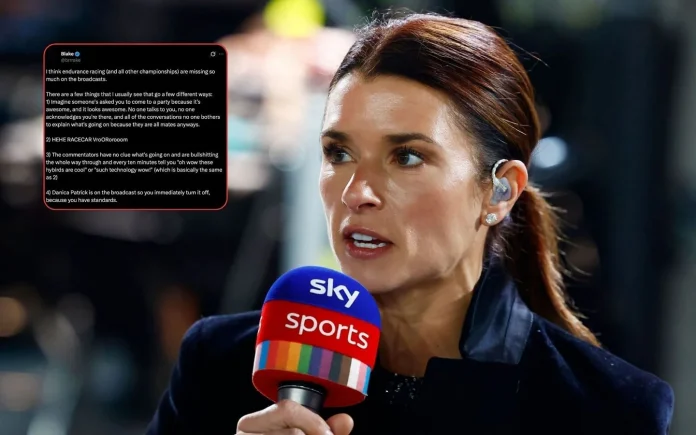Danica Patrick Sky F1 pundit criticism has surfaced after former Red Bull engineer Blake Hinsey publicly condemned her role during televised motor racing broadcasts, saying her on-screen presence prompts him to turn off the coverage. Hinsey’s comments, shared online, have sparked renewed conversation about the quality and appeal of Sky F1’s pundit lineup and the struggles TV coverage faces in keeping passionate fans engaged.
Former Engineer Voices Displeasure Over Broadcast Standards
Blake Hinsey, an engineer with a background at Red Bull between 2014 and 2021—and prior time at Force India (now Aston Martin)—took to social media to discuss the state of motorsport broadcasting, particularly endurance racing. He admitted to abandoning coverage whenever Danica Patrick appears, stating that broadcast “standards” influence his viewing habits. Hinsey’s stance illustrates dissatisfaction from within the racing community, especially among those with technical insights.
Danica Patrick, recognized for making history as the first woman to win an IndyCar race in 2008, ended her career as a professional driver in 2018 and began regular appearances as a TV pundit. She joined the Sky F1 punditry team during the 2021 United States Grand Prix in Austin, Texas, and has since contributed to both Formula 1 and a wide variety of other racing coverage, including prestigious events like the Indianapolis 500.
Patrick’s Role Divides Fans and Experts Alike
The presence of Danica Patrick in the Sky F1 broadcasting booth continues to stir strong opinions among motorsport followers. Despite her status as a trailblazing IndyCar and NASCAR figure from Wisconsin, reactions to her commentary are mixed, with some celebrating her expertise while others, like Hinsey, remain critical. Patrick’s prominent position within the broadcaster’s coverage since 2021 has made her a familiar face to international audiences, yet also a flashpoint for ongoing debates about quality and effectiveness in Formula 1 punditry.
Hinsey Highlights Broader Broadcast Shortcomings
While addressing Patrick’s involvement specifically, Hinsey also critiqued broader issues he observes with television coverage of endurance and other types of motor racing. He commented on the lack of clarity and accessibility for new viewers, comparing some televised coverage to exclusive parties where “no one acknowledges you’re there,” leaving fans disengaged and in the dark. His analogies illustrate the challenge TV producers face in capturing and retaining the interest of experienced and casual fans alike.
Hinsey’s commentary points to recurring frustrations: coverage that relies too much on in-jokes or fails to clearly explain strategy, technology, and the evolving story of the race. Fans, he argued, are often left with little more than repetitive banter about hybrid vehicles or simple excitement over race cars, without a compelling explanation of what actually unfolds on track. His experience as a broadcast consumer reflects broader concerns about how effectively networks like Sky F1 communicate the drama and complexity of motorsport.
Calls for Enhanced Visuals and Explanations
In response to what he sees as missed opportunities, Hinsey called for improved use of visuals and graphics within live race broadcasts, especially during complex endurance events. He advocated for detailed breakdowns of strategy, pit stops, and the critical moments that influence race outcomes, stating that storytelling driven by illustrative graphics could help both seasoned fans and newcomers understand developments at any point during long races. Additionally, he criticized on-screen displays such as timing towers in both F1 and IndyCar as being difficult to interpret, unlike energy meters in the World Endurance Championship, which he considered useful.
Hinsey’s insistence underscores an expectation from technically-minded viewers for higher analytical quality and clarity in coverage—a sentiment echoed by fans seeking accessible explanations and deeper insights into race strategy and performance trends. He argued that both technical and non-technical fans, including those like his own father who watch motorsports casually, would benefit from improved presentation and explanatory content during broadcasts.
Verbatim Perspectives on Racing Coverage Issues
While elaborating his points, Hinsey commented:
3) The commentators have no clue what’s going on and are bulls****ing the whole way through and every ten minutes tell you ‘oh wow these hybirds [sic] are cool
or such technology wow! (which is basically the same as 2)
He further described the limitations of coverage by stating:
But the cost of admission is just a bit more, but the broadcast and supplementary content is so poor in this area, you’re just going to have to rely on ‘2) hehehehEHeh RaceCaR’ which isn’t a useful method for growing the fanbase.
These remarks were shared by Blake Hinsey, who spent several years as an engineer with Red Bull and offers both technical insight and personal viewing preferences as context for his critique.
Ongoing Debate Over Pundit Quality and Viewer Engagement
The controversy initiated by Hinsey’s comments forms part of a larger discussion about the talent and effectiveness of current F1 pundits, with Sky F1 frequently featuring established names such as Martin Brundle, Nico Rosberg, and Damon Hill. While some fans find value in Patrick’s unique experience across racing disciplines, others align with Hinsey’s views, looking for more incisive analysis and a stronger connection between the broadcast and the unfolding racing narrative.
Motorsport stakeholders, including broadcasters, teams, and former drivers like Christian Horner and Damon Hill, are under increased pressure to meet rising expectations for informative, engaging, and visually driven coverage. As racing continues to grow its international audience, the ability to present technical details, strategic shifts, and key moments simply and clearly is likely to become even more important for attracting and retaining fans of all backgrounds.
The debate surrounding Danica Patrick’s role at Sky F1 underscores the ongoing challenge for broadcasters: balancing insider expertise with broad appeal and delivering coverage that satisfies longtime followers while welcoming newcomers. With the motorsports calendar full of marquee events like the Indianapolis 500, the United States Grand Prix in Austin, and a growing interest in endurance series, the conversation about pundit quality, presentation standards, and audience engagement will remain at the forefront of racing’s media landscape.


